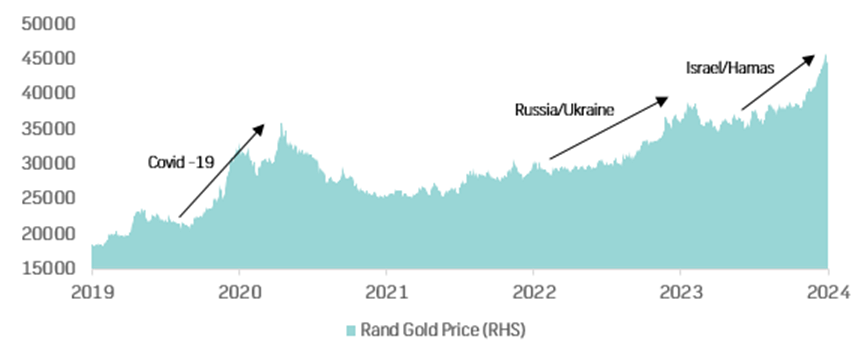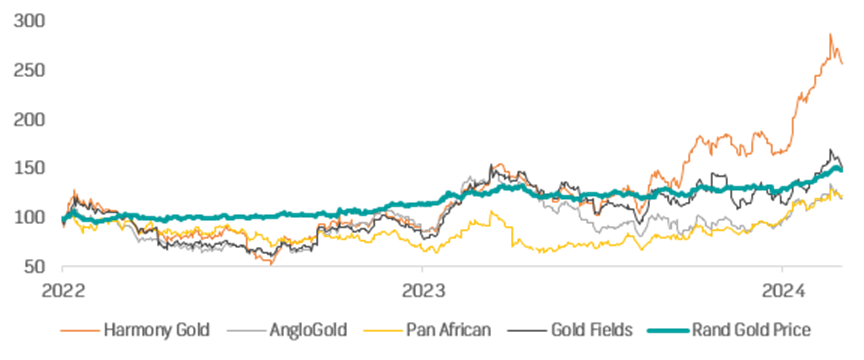
Chantal Marx
The gold price recently reached another all-time high, prompting investors to reassess their current exposure. Is it time to take profit for those who have held positions in gold or is it better to just hold on? And if an investor does not hold any gold – is there still a case to be made to initiate a position now?
Gold as a “safe-haven asset”
Gold, along with cash and certain other instruments, is generally regarded as a safe-haven asset. Safe-haven assets tend to provide relief to a portfolio during times of market stress. Risky assets like (most) equities are the growth engine of a portfolio – which add the bulk of returns during the good times, but during times of crises those assets can suffer severe drawdowns, and more reliance will be placed on other defensive assets to cushion overall portfolio returns. Risky assets are needed to generate growth over the long term, but at the same time, limiting drawdowns limits the extent and duration of recovery needed to return to a pre-crisis portfolio value.
When there is a lot of stress or uncertainty in markets, gold generally appreciates in value due to its safe-haven appeal. In the recent bull run, this demand has certainly offered support against a backdrop of major geopolitical risks.

The rand gold price – five-year history
Source: Bloomberg, FNB Wealth and Investments
Gold is also widely regarded as an inflation “hedge”, meaning that its value tends to rise with inflation – thereby protecting its holders from an erosion in purchase power when inflation is high.
Why the rally?
There are several reasons why we have experienced another gold bull market, the first being its safe-haven appeal. According to the World Gold Council, asset managers have been extremely active in the gold futures market as inflation concerns have remained front and centre and geopolitical tensions continue to intensify. “Large speculators” have followed suite.
Second, Central banks heavily increased their gold reserves in 2023 and continued to build reserves in the first few months of 2024. This has been a function of rising geopolitical risk and an active effort by some to reduce their dependency on the US dollar as a reserve currency (following the freezing of Russian central bank assets in 2022). Notably, China has been a heavy buyer so far this year, as well as India and Singapore.
Finally, Gold jewellery consumption, particularly in China post Covid-19 restrictions, has been strong. Gold Exchange Traded Fund (ETF) demand as well as demand for physical bars and coins have also been strong in China because of the relatively disappointing performance of the stock market and concerns over extreme softness in the property sector.
Is it worth holding on to your gold?
An argument can be made that some of the above drivers could still support the gold price this year. Considering ongoing global conflicts and other political and geopolitical dynamics, the safe-haven demand for gold could see demand from asset managers and speculators remain supported, at least until the end of the year past the US elections in November. Furthermore, the expectation is that central banks globally will continue to purchase gold – although it may be at a slower pace due to the high current price for the metal.
Furthermore, there are several traditional drivers of gold that has not yet “fired up”. Despite Chinese buying, physically-backed ETFs in fact sustained net outflows for nine months consecutively to the end of March.
Renewed dollar strength at the start of the year did little to curtail the gold bull run, but we do foresee the possibility of support from a weakening dollar should investors again become more positive on possible interest rate cuts by the Fed later this year. This scenario remains in the balance, however, as there is a possibility that the Fed may cut later and by less than many other global central banks resulting in a stronger US dollar.
There are other reasons to be cautious as well. Cost-of-living pressures could dampen jewellery demand and indeed retail investor demand for gold ETFs globally. There may also be some tactical changes coming through from asset managers in response to record high gold prices and perhaps more compelling opportunities elsewhere.
What about investors that don’t have exposure to gold?
There is an all-too-common temptation to try and time financial markets, and by timing, we mean in a binary fashion i.e., try and invest all your money in equities on the way up, and all your money in safe-haven assets on the way down. While the thinking is sensible, it is predicated on being able to identify the “top” and “bottom” of a market cycle… something that is very difficult to accomplish.
A more measured approach is to still consider adding gold to your portfolio now and to then take opportunities into potential weakness to increase your exposure over time. Typically, gold, or similar safe-haven assets (like cash), will make up 5% to 10% of your investment portfolio.
How to gain exposure to gold
There are several ways to gain exposure to gold besides physically purchasing bars and coins and storing it yourself:
· Krugerrands: Krugerrands are minted in South Africa by the South African Mint in conjunction with Rand Refinery. Each Krugerrand contains exactly one troy ounce of pure gold and is often many investors first choice of investment when considering getting exposure to gold. Krugerrands are highly liquid in the South African market and are considered legal tender in South Africa, but their true value lies in their gold content. For over a decade, clients have been able to purchase Krugerrands of various denominations through the FNB Banking platform (via Share Invest or Share Builder). Clients have the option to either have their coins securely held in custody by FNB or opt for physical delivery.
· Gold ETFs on the JSE: Investors can purchase a gold ETF on the JSE that tracks the spot price of gold. An ETF will physically purchase and store the gold and the price of the instrument will track the rand spot price of gold bullion. Options include the 1nvest Gold ETF (ticker: ETFGLD) and the ABSA NewGold ETF (ticker: GLD).
· Gold Mining Companies on the JSE: Investors can also gain exposure to the gold price by buying listed gold mining companies. This comes with the added complexities attached to mining, including costs and operational execution. Since the end of February 2022, around the invasion of Ukraine, most listed gold miners have underperformed the rand gold price. Given that these companies will be generating supernormal cash flows at current gold prices, this may offer a good alternative opportunity while gold remains at very high levels.

JSE listed major gold mining share prices versus the ZAR gold price (rebased to 100)
Chantal Marx, is Investment Research Head, FNB Wealth and Investment. She writes in her personal capacity.
INFO SUPPLIED.

